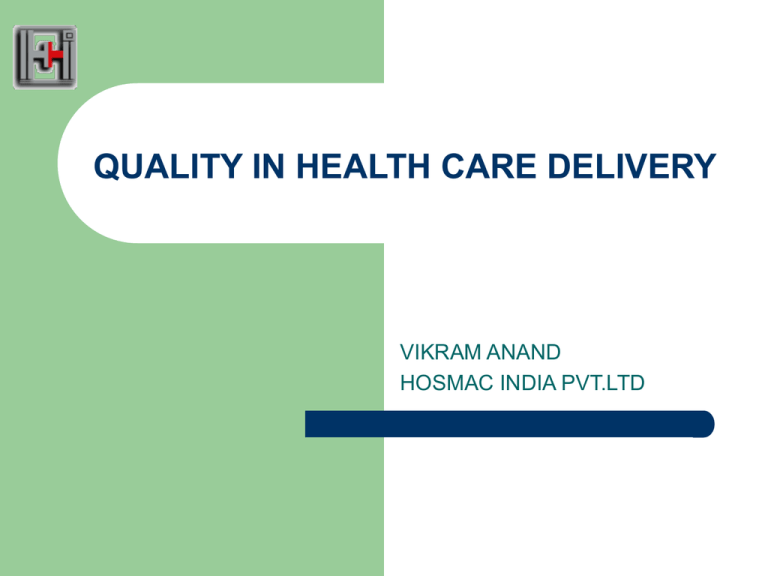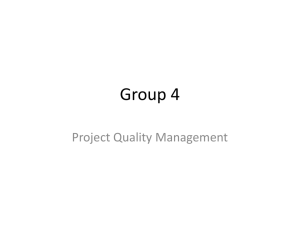Market Assessment Study For Proposed Hospital in Gurgaon
advertisement

QUALITY IN HEALTH CARE DELIVERY VIKRAM ANAND HOSMAC INDIA PVT.LTD Contents :Quality in Health Care Delivery Quality in Health Care Sector-Key Principles Infrastructure for Quality Assurance in Health Care Decision Making in Health Care Improvement Audit –Key Tool in Q.A Conclusion Quality in Health Care Sector : Key Principles HEALTH CARE The system that a Nation has built up and continuously maintains in order to combat (unnecessary) Death,Disease,Disability,Dissatisfaction and (social) Disruption A collection of curative,preventive,rehabilitative and promotive services Health care is a social and economical endeavor encompassing activities by providers,consumers,financiers and government within their respective value systems What’s wrong in today’s Health Care? Avoidable errors Underutilization of services Overuse of services Variation in services Communication problems Lack of Evidence Dissatisfied clients What can we do about it? Do nothing Better education and training Policing,Inspection,Punishment Change,Improve,Reward Comprehensive Approach:Quality Assurance Definition of Quality Why define quality of care? Reach consensus among employees Avoid confusion and in-house fighting Allow for sound evaluation Allow consumers to make a choice From the beginning there was chaos quality assessment quality assurance quality improvement continuous quality improvement Information technology values Quality :Terminology Quality Assurance: the overall philosophy on Quality and its Assurance Total Quality Management:one of the newest organizational and managerial approaches to Quality Assurance in the (not) for profit industry Continuous Quality Improvement:an important organizational and managerial mechanism for quality assurance in the health sector Continuous Quality Improvement Important elements: External and internal customer satisfaction Management leadership Involves all personnel Uses statistical methods Focuses on improvements Definition of healthcare quality Quality is working according to specifications Quality is providing effective services with a minimum of unnecessary use of resources Quality is to satisfy customers The Core Principles The essentials are: Assuring(I.e assessing and improving) quality is the responsibility of the provider Quality assurance is an evaluation and improvement process Of all the necessary attributes(knowledge,skills,attitudes,values) values and attitudes are the most important TOTAL QUALITY The end point of a development in phases: Focus on professional quality Focus on client satisfaction Focus on system effectiveness Focus on interconnections Organizational and societal unification Why improve my quality Because I know it is needed because I am told to do so because I must survive Because I need to follow the rules Today’s choice:SURVIVAL Mission Statement Rationale:programme SURVIVAL My programme is dedicated to Provide high-quality service to the members of the community Employ well-trained professionals Maintain a high safety record Provide a customer –friendly environment Plan high –quality services Identify priorities,goals and customers Set up working groups Describe service according to: -consumer and client needs - structure,process,outcome Make plans for evaluation Quality Planning Establish Quality project: goals and team Identify customers Determine client needs Design services to be provided Design delivery process Determine information need Use and evaluate Train professionals Select key professionals Design appropriate training Organize continuous training sessions Evaluate results of training including satisfaction Reward participants Repeat training regularly Evaluation Includes assessment and improvement Orientation:what are the possibilities? Selection:What is most appropriate? Implement: who is doing what? Collect and discuss the results Disseminate the results inside and outside Prepare for the next round Improvement of care Focus:Structure,Process and Outcome Structure:better equipment Process:doing the right things better! Outcome:obtain better results in - effective services -costs - client and employee satisfaction Improvement of structure Includes building,equipment,personnel,manuals, information systems,rules and regulations Includes new provisions,and updating and refurbishing of old provisions Need to include recording of inputs and costs Improvement of Process Principle:Doing the right things better! Doing the right things more effective! Doing the right things more efficient! Includes: Appropriate use of technology Appropriate use of personnel Client/provider relationship Improvement of outcome Focus: Programme effectiveness Programme efficiency Consumer and employee satisfaction Consumer and employee education Building and technology safety Community relations Information and communication needs Tools for Improvement Motivation Insight Evaluation methods Communication tools Dedicated personnel Dedicated Management Money That implies: Quality improvement is essential for survival Customer satisfaction is important for survival Monetary support will come only after wellexecuted quality assurance studies Infrastructure for Quality Assurance in Health Care Quality Assurance Universe – Big including small Small Concepts Methods Application Effectiveness Efficiency Criteria for good care Improvement activities Big •Patients •Providers •Organization •Technology •Information •Costs •Risks •Innovation Infrastructural Needs Assessment of actual situation: Structural analysis Rapid need assessment SWOT analysis Programme evaluation Part of certification Essentials A Policy Document for Quality Assurance A Blue Print for Quality Assurance Quality Assurance Policy Document Directed to Quality Assurance,not to quality Based on National Needs for Improvement of health services Items:definitions,principles,locus,focus,actors, costs,strategies Contd….. Size:less than 32 pages Production Time: less than 9 months Easy to understand ,no jargon Support by main parties(participants) Distributed widely Updated once in five years Listing the Infrastructure The Body The Engine The Petrol Assembly line and Maintenance The Route Map The Driver And then ……On the road! The Engine Policies Planning Mechanisms Implementation strategies Organization Resources Knowledge,skills,attitudes Value systems The Body The system for quality assurance Information systems Conformity between healthcare system and QA system The Driver Roles and Functions Education and Training License Rewards Remuneration Accountability Value Systems The Petrol Epidemiology of Health and disease Epidemiology of quality(ABNA) Willingness to evaluate/be evaluated Willingness to Change and Improve Legislation Value Systems Epidemiology of Quality Rumours and Hearsay Surveys:Opinions,Dissatisfaction Registration of Facts:Incidents Registration of Facts: Trends ABNA:Achievable Benefit Not Achieved Maintenance Support mechanisms Research and Development Internal Quality Assurance System Value Systems Assembling Quality Assurance A Laboratory (be in control) Real Life situations(hope the best) Value Systems Whatever you do , you still need a Manual and a Road Map! Decision Making in Healthcare Improvement Key Concerns: To find the decision makers: Who decides about quality? Who decides about quality improvement? To identify the client in health care quality improvement Roles and Functions in Decision making in Quality Improvement The Consumers The Professionals The Managers The Government,Policy Makers The Seven Roles of the Consumer Definers of Quality Evaluators of Quality Informants of Care Co-producers of care Targets of Quality Assurance Controllers of Practitioner Behavior Reformers of Health Services The Seven Roles of the Provider To be accountable To provide quality care(plan,implement) To safeguard the quality of care services To be evaluated by colleagues To evaluate his colleagues To continue learning To collaborate with colleagues and management Seven Roles and Functions of Management Do their job(Quality Management) Exert leadership Participate in Quality Management Communicate on Quality matters Be accountable re: quality Evaluation of Quality Management Provide resources Role of Government Still open: Active role with responsibilities Support role with limited responsibilities No role at all AUDIT Key Tool for QA Implementation History of Audit Global Development: Until 1980s : the only mechanism available since 1985: superseded by CQI Since 1995: rebirth of audit as tool for professionals in CQI programmes Historical definition: audit is retrospective review of medical care as laid down in the medical record Audit: a modern definition Is a criterion –referenced review of health care delivery to establish quality followed by, if necessary, specific activities to improve care delivery The method is used by professionals to assess and, if needed, improve the quality of their work Audit :Applied with little more discipline Practical Solutions: Focusing on relevant health care delivery Focusing on multidisciplinary professional work Retrospective and concurrent in orientation Focus on assessment and improvement Based on reliable and valid data Not more time consuming than others Audits’ Building Stones A well selected topic A limited number of relevant criteria Well selected reliable and valid data A functioning judgment procedure A will to change when needed Relevant changes leading to improvements What are benefits in health care? Improvement in health status Increase in satisfaction Elimination of impairment Elimination of disability Elimination of risks Elimination of malfunctioning all due to present health care What is ABNA? ABNA Maximum conceivable benefit Achievable benefit Benefit not achievable Achievable benefit achieved Achievable benefit not achieved Errors of commission Errors of omission Well –chosen priorities Priorities for Quality Improvement: Are formulated in a clear <problem> mode Identify targets with high ABNA Identify all players in the field including patients Provide insight into attainable improvements Put the responsibility for quality improvement where it should be Conclusion We should: Focus on generalities,later on specifics! Focus on gaps and weaknesses! Each country gets the quality assurance system it deserves! Thank You








